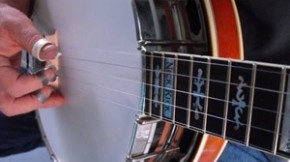Should I Put One Finger or Two Fingers on the Banjo Head
Should I Put One Finger or Two Fingers on the Banjo Head
article by Ross Nickerson
Should I put two fingers on the head? when playing banjo? One finger down? If so, which finger? When picking what's the difference between planting two fingers or just one? The advantage? Why put any fingers down?
This has to be one of the most asked about and discussed topics facing banjo students as they learn to play. Let me see if can add some insight into this topic for you and help make the learning process easier.
First of all, let's start by saying, ONE FINGER DOWN IS OK! Two fingers down is hard! I've been teaching for a long time and maybe one in twenty-five students can put two fingers down on the head easily without it causing any difficulty moving the middle finger. The last thing someone learning to play the banjo needs is another obstacle that makes them feel discouraged! You can pick a banjo with one finger planted. In fact, there are a lot of people who do, and pick well. OK! That being said let me explain some of my takes on this. I hope it may help you to understand the big picture and to not let this become any bigger of an issue then it should be for you!
The answer to this may lie in understanding the purpose for placing the finger or fingers on the head. Instead of asking yourself how you should approach what finger or fingers to plant, perhaps you should ask yourself what you are trying to achieve by doing this. Take note…. if you can achieve your goals and priorities with regard to your picking technique with one finger planted on the head, then you should play that way, move on and let it go. However, if you feel you have a better chance of achieving better picking technique with two fingers planted on the head, then it will be worth it to you to train yourself to plant two fingers while picking. My point is, I feel it's more important to concentrate on doing your best to the many achieve important priorities of picking hand technique. That is what you should focus on, not what others say to do or not do with regard to planting fingers. Focus on the business of making good music and giving your self what you feel is the best chance to learn and progress.
Some Picking Hand Priorities
Stability and consistency in the position of the picking hand.
Things should feel the same to you every time you play with regard to your hand position. Basically, so you can play without looking!
Picking straight up on the strings
You should be striking the strings with your picks as close to a right angle as possible, with direct contact and not hitting the string with the picks at a slanted angle. One of the biggest advantages I felt I gained it gave me switching to two fingers planted down (after playing for 3 years planting one finger down) was achieving a better angle of attack on the strings. However, I bet if you tried or at least were aware of the importance of the angle of attack on the strings, this could be achieved with one finger down. Simply put, hit the strings as straight as you can and you'll get more volume and much better tone. One finger down can cause the hand to droop. For instance, the palm being to close above the tailpiece will cause a bad angle. So, try not to do that. Awareness may be all you need on this topic.
Digging into the strings and getting leverage
When I switched to two fingers, one of the things I did at the same time was arch my wrist more. All of a sudden I was getting better volume and better tone by striking the strings at a straighter angle. I also felt like I had better leverage and more control with my picking hand, which improved my overall playing on a lot of levels. But you can arch your wrist more, and think about leverage and tone with one finger down as well. Focus on the leverage and tone, not the number of fingers planted
I will have to be honest that I feel planting two fingers has some advantages, which is the way I play, and I trained my fingers to do it. However it would serve little purpose for me to say…that is the only way to do it; simply because that it isn't the only way it can be done.
Just remember, for instance, if you were to come to one of my workshops, I wouldn't be judging you on what finger or fingers you place on the head, but rather, on whether or not you were achieving good pick angle, tone and leverage. I would also be checking to make sure you weren't tight and bound up because of the way you were holding your hand, things like that, along with some of the other important aspects I'm discussing with you now in this article. That is what would be important to me on your behalf.
OK!
Here are some tips!
Pick close to the bridge when you practice. It builds up strength in the right hand and if you don't, when you try to pick close to the bridge for more volume or a crisper tone at a jam, your hand may feel like it's in sand.
When you pick close to the bridge, remember that it's ok if you need to place your planted fingers behind the bridge (as long as they don't touch the bridge.) What matters is that you are hitting at least within an inch or closer to the bridge on the first string with the middle finger. If you have long fingers you may have your planted finger or fingers an inch or two behind the bridge. That's ok, as long as you pick the strings in the right place and don't touch the bridge. Touching the bridge kills tone and volume. Also, you shouldn't push on the head with your planted fingers.
To arch your wrist, try this.
Hold out your hand and shake it loose.
Place your forearm further up on the armrest, (almost half way between the wrist and elbow for some people).
Plant your finger or fingers in position to pick.
Now bring the elbow in significantly, almost touching the side of your ribs.
You should have an arch in your wrist now. If not, keep trying.
Next ask yourself about the angle you're striking the strings. If it's not as straight as you would like move the side of your hand (the side your pinky is on) up towards the bridge. That part is particularly hard to describe in words but again, pick as straight up as you can, you'll find a way.
If your thumb is now hitting the strings at an angle, and the fingerpicks aren't, with regard to that, having to choose, or temporarily choose between the thumb hitting the strings straight or the fingerpicks hitting the strings straight, the thumb hitting at a slight angle may be the lesser of two evils. I'm not going to recommend you pick with either the thumb or fingers at a bad angle but rather I am commenting that I see that in students sometimes and the thumb pick may have more leeway in that regard, maybe because the tone is rounder and thumb picks normally have a bigger blade. If you listen, I think you'll know what I mean. Do the best you can!
I hope this is helpful. I could have devoted more of the focus of this article on ways to learn to put two fingers down (if you don't already) but I really feel it's more important for everyone to have a little more insight on how hand position effects their playing. And to remind anyone who might be wondering that the important priorities in picking can be achieved with one finger down. I also wanted to get the message out there, and simply say, care about the important things! Timing, tone, building strength, speed, and control, the list goes on, let that be your guide. These important picking priorities should be used to help us answer these issues and fuel our desire to practice and progress. Don't let it be a stumbling block. Move forward!
I have questions and answers like these on my member's only site at BanjoTeacher.com with instruction, tabs, and tips on the my main site as well. My book, The Banjo Encyclopedia has a couple of pages devoted to this subject with photos and other important tips too.
Thanks!
Sincerely, Ross Nickerson
www.banjoteacher.com








